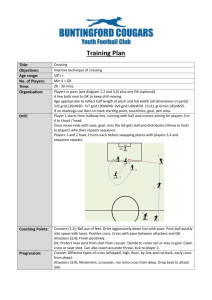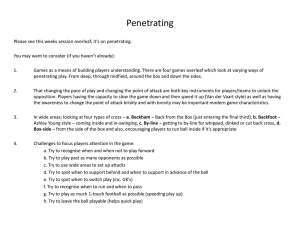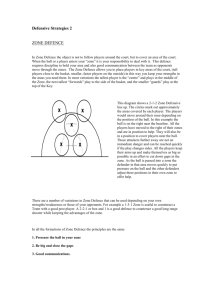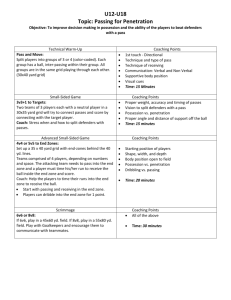Coaching Team Tactics for U-11`s and U-12`s
advertisement
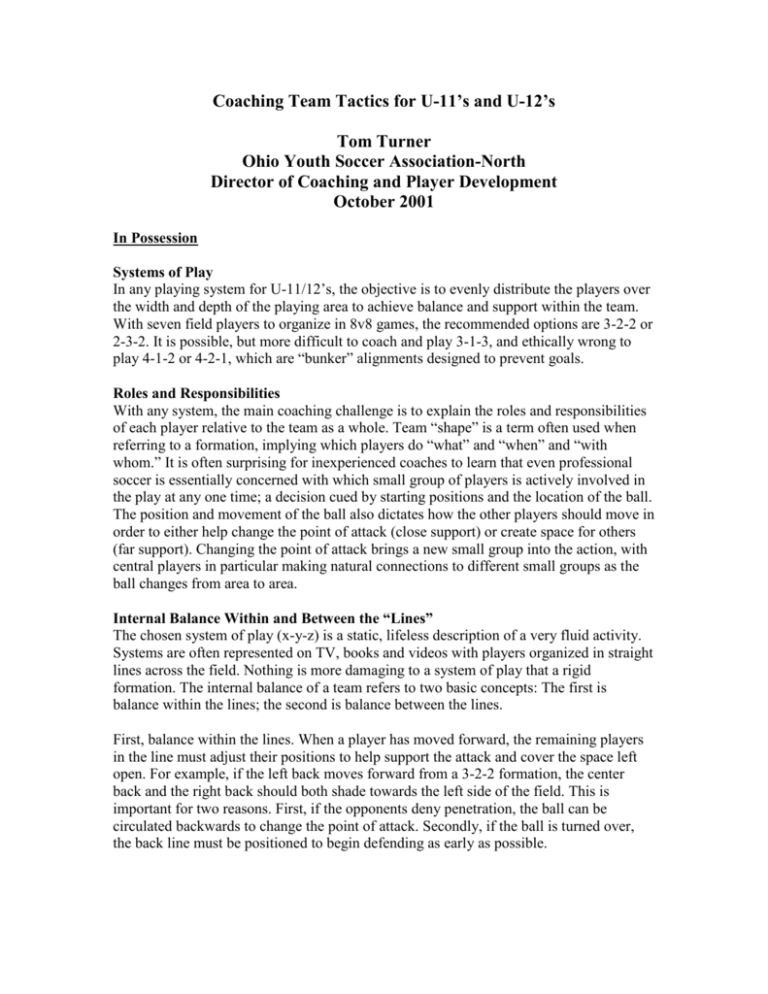
Coaching Team Tactics for U-11’s and U-12’s Tom Turner Ohio Youth Soccer Association-North Director of Coaching and Player Development October 2001 In Possession Systems of Play In any playing system for U-11/12’s, the objective is to evenly distribute the players over the width and depth of the playing area to achieve balance and support within the team. With seven field players to organize in 8v8 games, the recommended options are 3-2-2 or 2-3-2. It is possible, but more difficult to coach and play 3-1-3, and ethically wrong to play 4-1-2 or 4-2-1, which are “bunker” alignments designed to prevent goals. Roles and Responsibilities With any system, the main coaching challenge is to explain the roles and responsibilities of each player relative to the team as a whole. Team “shape” is a term often used when referring to a formation, implying which players do “what” and “when” and “with whom.” It is often surprising for inexperienced coaches to learn that even professional soccer is essentially concerned with which small group of players is actively involved in the play at any one time; a decision cued by starting positions and the location of the ball. The position and movement of the ball also dictates how the other players should move in order to either help change the point of attack (close support) or create space for others (far support). Changing the point of attack brings a new small group into the action, with central players in particular making natural connections to different small groups as the ball changes from area to area. Internal Balance Within and Between the “Lines” The chosen system of play (x-y-z) is a static, lifeless description of a very fluid activity. Systems are often represented on TV, books and videos with players organized in straight lines across the field. Nothing is more damaging to a system of play that a rigid formation. The internal balance of a team refers to two basic concepts: The first is balance within the lines; the second is balance between the lines. First, balance within the lines. When a player has moved forward, the remaining players in the line must adjust their positions to help support the attack and cover the space left open. For example, if the left back moves forward from a 3-2-2 formation, the center back and the right back should both shade towards the left side of the field. This is important for two reasons. First, if the opponents deny penetration, the ball can be circulated backwards to change the point of attack. Secondly, if the ball is turned over, the back line must be positioned to begin defending as early as possible. The relative positions of the midfielders can also indicate different problems relating to balance within a line. If a team is organized with three in midfield (2-3-2), the internal balance is poor when all three players are separated across the width of the field and at the same depth from the goal. This arrangement leaves the line with poor supporting angles and distances. The exception to this problem is during the build-up (see below). Similarly, the balance within the line is also poor when all three players are grouped together in the center of the field, leaving the midfield devoid of either width or depth. The second concept is balance between the lines, with the primary issue being the number of players available to support or defend in each third of the field. In both examples above, if too many defenders or midfielders move forward at the same time, the team would lack the support necessary to circulate the ball or change the point of attack; in addition, the team would be highly vulnerable to counter-attacks. If the basic purpose of any U-11/12 system is to evenly distribute players over the length and breadth of the field, having too many players in one area at the same time presents obvious problems. The choice between the number of forwards presents a final aspect of balance. When a coach chooses to play with only one forward, the opportunity to build an attack is very difficult and often results in kick-ball. This arrangement also places an excessive burden on one player to cover a very large area. Finally, U-11/12 is an important stage for young forwards to begin to appreciate the skills and possibilities involved in a “striking partnership,” rendering one-striker systems as poor choices for U-11/12’s. The Build-up The build-up takes place in the defensive and midfield thirds of the field. When attempting to build out of the back, it is important for the midfielders and forwards to create space for the defenders and goalkeeper to start circulating the ball. The simplest approach is to push the forwards as far away from goal as the offside rule will permit, and for the midfielders to move out behind them. This will leave the goalkeeper with time and space to safely connect short passes with teammates, unless the opposition is positioned to high pressure the ball, in which case a punt or throw may be better options. In a three-player midfield (2-3-2), the flank players will move wide and downfield, leaving the central player with operating room to help the fullbacks and goalkeeper build the ball into the middle third of the field. At times during the initial part of the build-up, the midfield may become “flat” across the width of the field, but this will change as players check backwards to “show” for the ball. When building out of the back, flank midfielders should not be restricted to only showing for passes down the sideline. In a two-player midfield (3-2-2), both players will operate in the central channel and move in opposition to each other (one up-one back, one left-one right) to provide internal balance. In the case of a three-player midfield, the flank midfielders provide the team’s width during the build-up; in the case of a two-player midfield, the outside backs will provide the team’s width. The first responsibility of the forwards during the build-up is to create space in the defensive and midfield thirds by drawing opponents away from the ball. Their secondary responsibility is to provide long support for forward passes. Given the passing range of most eleven and twelve year-olds, it is unrealistic to expect long passes to be consistently played over defenders’ heads, so learning to play with their backs to goal is a critical skill for forwards during the period. When passed to, the primary role of the forwards during the build-up is to secure possession of the ball and pass to midfielders or defenders supporting from behind. The Attack When the ball is played into or through the midfield area and the opponents have begun to retreat against the threat of a through pass, the build-up has been successful and the attacking phase of play has begun. In the attacking phase, the team is trying to create scoring chances. Chances can be created from the flanks or through the center of the field. Chances can also be created though individual initiative, by simple passes, or by players interchanging positions and combining passes. The ability to recognize a scoring opportunity and the willingness to take risks are critical dimension of attacking play. Against organized defenses, the ball must often be circulated in the attacking half of the field in order to find an opening to challenge the goal. It is during this phase of play that a team’s ability to possess the ball requires the support of players from the back line. The ability of players, and therefore teams, to create scoring chances or possess the ball in the attacking area of the field is the most difficult aspect of soccer at all levels, and it is here that all the lessons of youth either flourish or perish. Direct Play It is sometimes noted that “Attractive teams die in beauty.” This comment refers to the practical necessity of direct play as a natural complement to possession soccer. When passes can be connected to strikers at the front of the team, that option is generally preferred because opponents are placed on the wrong side of the ball and therefore out of the game. Similarly, when players develop the strength and ability to play longer passes into space behind defenses, that capability should also become integral to the team’s style of play. However, as with most good things, balance and moderation are key factors. Teams that play very direct, very predictable soccer rarely have much to fall back on when the game is not going to plan. In contrast, the team that can vary their style to better match an opponent, or the score, or the weather or field conditions, or the match situation, or even the mood of the players, are a much more difficult and dangerous opponent to face. Direct play is a vital weapon in America’s soccer arsenal, but it must not be championed as our primary or sole strategy. Counter-Attacking A team is most vulnerable to a counter-attack at the moment when it has just lost possession. This is because players are more spread out when their team is attacking. The decision to counter-attack is based on numbers and location. In general, if the defending team is caught with even numbers or numbers down, the counter is on, unless the turnover occurs so far from goal that there is no real advantage to be gained by going forward. In this case, a new build-up would begin. A turnover in the center of the field often creates better counter possibilities than a turnover on the flank, because more space and better passing angles are often available. In either case, however, the key to a successful counter is the ability of players to quickly read the situation and utilize the available space and the available or arriving support. As basic rules of thumb for counter-attacking, the ball should be played forward to feet or space as early and as quickly as possible, with support anticipated from those teammates closest to the action. If no forward support is available, the ball should be dribbled forward at speed, with the decision to continue the thrust based on the possibility of teammates arriving into good supporting positions. In all counter-attack situations, two basic principles should be held constant. First, when a technical or tactical breakdown causes the counter-attack to stall, the ball should be possessed and circulated, not forced forward. Second, it is a mistake of epic proportions to be countered following a counter-attack because the remaining players did not adjust their positions to balance for those who ventured forward. It is the responsibility of the remaining players to organize the defense while a counter is taking place. Out of Possession Zonal Defending Conceptually, zonal defending can be thought of as “block” defending, with the players moving as a group to deny penetration and win possession. It is tactically naïve to defend man-for-man on a team basis, for the simple reason that players cannot easily help each other defend. The more efficient approach is to organize players zonally, with players near the ball defending opponents man-to-man, and players away from the ball moving backwards or forwards and centrally or laterally to provide teammates with cover and balance. If a team is lined up to play 3-2-2, for example, the team will also defend in that shape, except when a counter-attack forces emergency action. Two considerations are foundational to good zonal defending. One is compactness; the other is balance. With regard to compactness, when the forward line is pressuring the ball, the midfield and defensive lines should push up to limit the space available to the opponents between the three lines. If the lines do not move together, two problems can emerge. First, space will be available between the forwards and the midfielders or between the midfielders and the defenders for the attackers to pass to teammates in relatively open space; second, the three lines will not be well placed to help each other defend from the front and back of the opponents. The final piece of a good compact defensive organization is the position of the goalkeeper. Provided the goalkeeper moves forward to help defend any long passes behind the defense, the team will have achieved a compact shape from front to back. A team is well balanced when the players furthest from the ball move towards the middle of the field to close open spaces and help teammates defend. Just as compactness refers to the defensive spread of players up and down the field, balance refers to the defensive spread of players from side to side. When a team is well balanced, the attacking space conceded to the opponents is on the weak (far) side of the field, if the ball is on a flank; and towards either sideline, if the ball is in the middle of the field. One final, but important point about zonal defending is the tactical cue for balancing and compacting. As a basic rule of play, unpressured opponents have better vision of the field and therefore more time and space to play long passes. The timing and the extent to which back players and weak side players squeeze towards the ball must be based on the level of pressure on the ball and the technical range of the opponent. If an unpressured opponent can kick the ball directly over or across the “block,” the team has overcommitted. Pressing and Dropping All good teams vary the point at which they begin to defend, based on established team tactics and the match situation. As a rule of thumb, team defending should begin as soon as the opponents can be put under pressure. This opportunity may arise as soon as the ball is lost, or may occur further downfield when an attacker can being channeled (harried) towards a sideline or into an area where they are outnumbered by defenders. The decision to “press,” or “drop off” and defend further from goal, should be based on the probability of winning possession and the ability of the other team to play through pressure. Recovering If the opponent is building their attack or countering, any defenders played out of the game must recover towards their own goal. The marker for any recovery runs in the center of the field is generally the penalty spot, while the near post is the marker when recovering from the flank. Forwards should generally only recover far enough to reestablish their position within the zone, while midfield players and defenders should recover to their original positions, unless a teammate has exchanged positions during the previous attack. It is important that recovering players be encouraged to “double down” from behind on any opponent being delayed by a defender. In extreme situations when the team is recovering against a counter-attack, or against an attacker running unopposed towards goal, the closest player, regardless of position, must take responsibility for recovering far enough to pressure the ball. Transition To Attack A team is most vulnerable to counter-attack goals when it loses possession with players spread out in an attacking shape. The tactical mindset of any player coming into possession should therefore be a) goal, b) assist, c) forward pass. When a goal cannot be scored and a counter-attack is not possible, the team should start to build their attack. This is achieved by players not in immediate support moving away from the ball and creating space for the team to maintain possession and circulate the ball. The most common mistake of inexperienced players is to begin building an attack from the close quarters of a defensive shape. To Defense The best defense against the counter-attack is to immediately pressure the ball before it can be played or dribbled forward, and any passes or dribbles forced backwards or sideways will buy time for teammates to recover behind the ball. If the pressing action of one player provides an opportunity for the team to press as a group, they should do so. If the pressing action of one player simply negates the possibility of a counter-attack, the general rule of thumb is to only recover as deep as required to re-establish an organized defensive shape. Restarts At the U-11/12 level, every restart situation common to top-level soccer will be part of the 8v8 game. Coaching should address the attacking and defending tactics of corner kicks, goal kicks, place kicks, throw-ins, indirect free kicks and direct free kicks; even drop balls and penalty kicks will be common features of play. From a developmental perspective, restarts, at the U-11/12 level, are a low teaching priority; however, players can and should be helped to explore creative solutions to dealing with these game situations. Fitness The basic elements of soccer fitness encompass speed, acceleration, agility, balance, power, strength, coordination and flexibility. In particular, the expansion of anaerobic capacity and recovery from anaerobic activity are critical to the demands of modern soccer. In those situations where a team practices only once or twice each week, activities designed to enhance performance in specific fitness areas are impractical. At the U-11/12 level, competitive small-sided games and individual technical activities with the ball are viable and efficient alternatives for developing the fitness and motor patterns specific to soccer.

